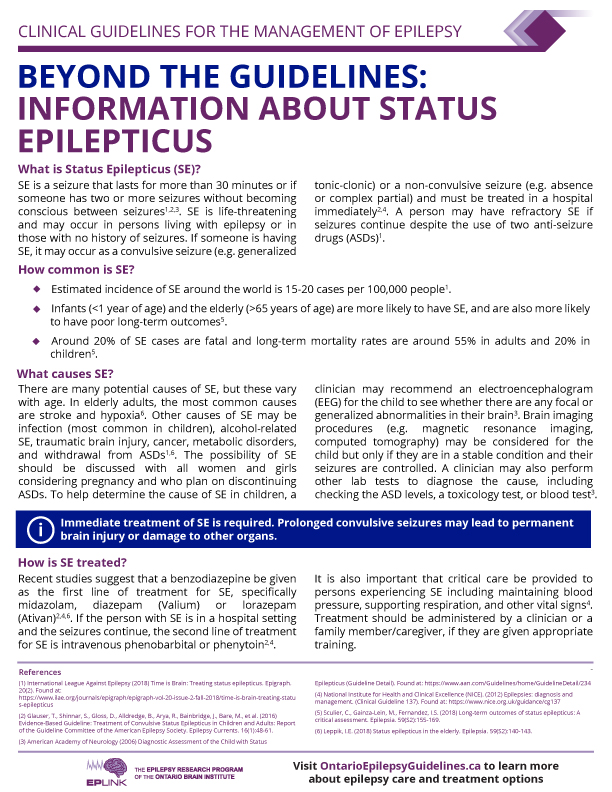Download a PDF of the info sheet at the links below:

What is Status Epilepticus (SE)?
SE is a seizure that lasts for more than 30 minutes or if someone has two or more seizures without becoming conscious between seizures. SE is life-threatening and may occur in persons living with epilepsy or in those with no history of seizures. If someone is having SE, it may occur as a convulsive seizure (e.g. generalized tonic-clonic) or a non-convulsive seizure (e.g. absence or complex partial) and must be treated in a hospital immediately. A person may have refractory SE if seizures continue despite the use of two anti-seizure drugs (ASDs).
How common is SE?
- Estimated incidence of SE around the world is 15-20 cases per 100,000 people.
- Infants (<1 year of age) and the elderly (>65 years of age) are more likely to have SE and are also more likely to have poor long-term outcomes.
- Around 20% of SE cases are fatal and long-term mortality rates are around 55% in adults and 20% in children.
What causes SE?
There are many potential causes of SE, but these vary with age. In elderly adults, the most common causes are stroke and hypoxia. Other causes of SE may be infection (most common in children), alcohol-related SE, traumatic brain injury, cancer, metabolic disorders, and withdrawal from ASDs. The possibility of SE should be discussed with all women and girls considering pregnancy and who plan on discontinuing ASDs. To help determine the cause of SE in children, a clinician may recommend an electroencephalogram (EEG) for the child to see whether there are any focal or generalized abnormalities in their brain. Brain imaging procedures (e.g. magnetic resonance imaging, computed tomography) may be considered for the child but only if they are in a stable condition and their seizures are controlled. A clinician may also perform other lab tests to diagnose the cause, including checking the ASD levels, a toxicology test, or blood test.
Immediate treatment of SE is required. Prolonged convulsive seizures may lead to permanent brain injury or damage to other organs.
How is SE treated?
Recent studies suggest that a benzodiazepine be given as the first line of treatment for SE, specifically midazolam, diazepam (Valium) or lorazepam (Ativan). If the person with SE is in a hospital setting and the seizures continue, the second line of treatment for SE is intravenous phenobarbital or phenytoin. It is also important that critical care be provided to persons experiencing SE including maintaining blood pressure, supporting respiration, and other vital signs. Treatment should be administered by a clinician or a family member/caregiver, if they are given appropriate training.
